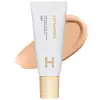What's inside
What's inside
 Key Ingredients
Key Ingredients

No key ingredients
 Benefits
Benefits

 Concerns
Concerns

 Ingredients Side-by-side
Ingredients Side-by-side

Water
Skin ConditioningHydrogenated Polydecene
EmollientGlycerin
HumectantMethyl Gluceth-20
HumectantGlycol
HumectantDiglycerin
HumectantOctyldodecanol
EmollientCitrus Aurantium Amara Flower Extract
RefreshingChlorphenesin
AntimicrobialButylene Glycol
HumectantCaprylyl Glycol
EmollientCarbomer
Emulsion StabilisingPolyhydroxystearic Acid
EmulsifyingDisteardimonium Hectorite
StabilisingPolyglycerin-3
HumectantTamarindus Indica Seed Gum
Emulsion StabilisingTrisodium Ethylenediamine Disuccinate
Aluminum Hydroxide
EmollientPropylene Carbonate
SolventAmodimethicone
Sodium Hydroxide
BufferingSodium Lauroyl Glutamate
Alcaligenes Polysaccharides
EmollientParfum
MaskingLysine
Skin ConditioningGlucose
HumectantMagnesium Chloride
Ultramarines
CI 77491
Cosmetic ColorantCI 77492
Cosmetic ColorantCI 77499
Cosmetic ColorantCI 77891
Cosmetic ColorantMica
Cosmetic ColorantWater, Hydrogenated Polydecene, Glycerin, Methyl Gluceth-20, Glycol, Diglycerin, Octyldodecanol, Citrus Aurantium Amara Flower Extract, Chlorphenesin, Butylene Glycol, Caprylyl Glycol, Carbomer, Polyhydroxystearic Acid, Disteardimonium Hectorite, Polyglycerin-3, Tamarindus Indica Seed Gum, Trisodium Ethylenediamine Disuccinate, Aluminum Hydroxide, Propylene Carbonate, Amodimethicone, Sodium Hydroxide, Sodium Lauroyl Glutamate, Alcaligenes Polysaccharides, Parfum, Lysine, Glucose, Magnesium Chloride, Ultramarines, CI 77491, CI 77492, CI 77499, CI 77891, Mica
Water
Skin ConditioningCaprylic/Capric Triglyceride
MaskingGlycerin
HumectantLimnanthes Alba Seed Oil
Skin ConditioningPropanediol
SolventSqualane
EmollientC9-12 Alkane
SolventErythritol
HumectantDicaprylyl Ether
EmollientPolyglyceryl-6 Polyricinoleate
EmulsifyingOctyldodecanol
EmollientDisteardimonium Hectorite
StabilisingDistarch Phosphate
AbsorbentPhenoxyethanol
PreservativePolyglyceryl-2 Isostearate
EmulsifyingMagnesium Sulfate
Zinc Stearate
Cosmetic ColorantSodium Benzoate
MaskingSodium Dehydroacetate
PreservativeButyrospermum Parkii Butter Extract
Skin ConditioningHydrogenated Lecithin
EmulsifyingCoco-Caprylate/Caprate
EmollientBenzoic Acid
MaskingPropylene Carbonate
SolventSodium Hyaluronate
HumectantDehydroacetic Acid
PreservativeLecithin
EmollientEthylhexylglycerin
Skin ConditioningTocopherol
AntioxidantAscorbyl Palmitate
AntioxidantNephelium Lappaceum Peel Extract
Skin ConditioningCitric Acid
BufferingStearic Acid
CleansingCI 77891
Cosmetic ColorantIron Oxides
Water, Caprylic/Capric Triglyceride, Glycerin, Limnanthes Alba Seed Oil, Propanediol, Squalane, C9-12 Alkane, Erythritol, Dicaprylyl Ether, Polyglyceryl-6 Polyricinoleate, Octyldodecanol, Disteardimonium Hectorite, Distarch Phosphate, Phenoxyethanol, Polyglyceryl-2 Isostearate, Magnesium Sulfate, Zinc Stearate, Sodium Benzoate, Sodium Dehydroacetate, Butyrospermum Parkii Butter Extract, Hydrogenated Lecithin, Coco-Caprylate/Caprate, Benzoic Acid, Propylene Carbonate, Sodium Hyaluronate, Dehydroacetic Acid, Lecithin, Ethylhexylglycerin, Tocopherol, Ascorbyl Palmitate, Nephelium Lappaceum Peel Extract, Citric Acid, Stearic Acid, CI 77891, Iron Oxides
 Reviews
Reviews

Ingredients Explained
These ingredients are found in both products.
Ingredients higher up in an ingredient list are typically present in a larger amount.
Ci 77891 is a white pigment from Titanium dioxide. It is naturally found in minerals such as rutile and ilmenite.
It's main function is to add a white color to cosmetics. It can also be mixed with other colors to create different shades.
Ci 77891 is commonly found in sunscreens due to its ability to block UV rays.
Learn more about CI 77891Disteardimonium Hectorite comes from the clay mineral named hectorite. It is used to add thickness to a product.
It can also help stabilize a product by helping to disperse other ingredients.
Hectorite is a rare, white clay mineral.
Learn more about Disteardimonium HectoriteGlycerin is already naturally found in your skin. It helps moisturize and protect your skin.
A study from 2016 found glycerin to be more effective as a humectant than AHAs and hyaluronic acid.
As a humectant, it helps the skin stay hydrated by pulling moisture to your skin. The low molecular weight of glycerin allows it to pull moisture into the deeper layers of your skin.
Hydrated skin improves your skin barrier; Your skin barrier helps protect against irritants and bacteria.
Glycerin has also been found to have antimicrobial and antiviral properties. Due to these properties, glycerin is often used in wound and burn treatments.
In cosmetics, glycerin is usually derived from plants such as soybean or palm. However, it can also be sourced from animals, such as tallow or animal fat.
This ingredient is organic, colorless, odorless, and non-toxic.
Glycerin is the name for this ingredient in American English. British English uses Glycerol/Glycerine.
Learn more about GlycerinOctyldodecanol is a fatty alcohol. It is primarily used to enhance the texture of products.
As an emulsifier, Octyldodecanol helps prevent the oils and waters from separating. It also prevents ingredients from creating foam when shaken.
Octyldodecanol is created by reducing fatty acid to an alcohol.
Due to its high molecular weight, it does not get absorbed into the skin.
Learn more about OctyldodecanolThis ingredient is a solvent. It helps dissolve active ingredients and alter the texture of products.
Propylene Carbonate is commonly used in makeup and with clay, such as montmorillonite or bentonite.
Studies show this ingredient to be safe for cosmetics. When it is undiluted, it can cause skin irritation. (It is always diluted in skincare and makeup). This ingredient is water-soluble.
Propylene Carbonate is created from propylene glycol and carbonic acid.
Learn more about Propylene CarbonateWater. It's the most common cosmetic ingredient of all. You'll usually see it at the top of ingredient lists, meaning that it makes up the largest part of the product.
So why is it so popular? Water most often acts as a solvent - this means that it helps dissolve other ingredients into the formulation.
You'll also recognize water as that liquid we all need to stay alive. If you see this, drink a glass of water. Stay hydrated!
Learn more about Water